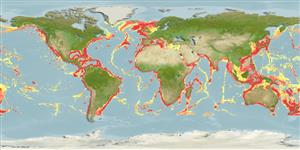Ελασμοβράγχιοι (καρχαρίες και σαλάχια) (sharks and rays) >
Hexanchiformes (Frill and cow sharks) >
Hexanchidae (Cow sharks)
Etymology: Hexanchus: Greek, exa = six + Gree, agcho, narrow (Ref. 45335); griseus: From the Latin 'griseus' meaning gray (Ref. 27436).
Περιβάλλον / Κλίμα / Εύρος
Οικολογία
; Θαλασσινό(ά) βαθύβιο(ς); ωκεανόδρομο(ς) (Ref. 51243); εύρος βάθους 1 - 2500 m (Ref. 58302), usually 180 - 1100 m (Ref. 45445). Subtropical, preferred 25°C (Ref. 107945); 65°N - 48°S, 180°W - 180°E
Circumglobal: In tropical and temperate waters; (Ref. 13573). Western Atlantic: North Carolina to Florida (USA) and northern Gulf of Mexico to northern Argentina. Eastern Atlantic: Iceland and Norway to Namibia, including the Mediterranean. Indian Ocean: Madagascar, Mozambique, South Africa, and Arabian Sea (Ref.85183). Western Pacific: eastern Japan to New Zealand and Hawaii. Eastern Pacific: Aleutian Islands, Alaska to Baja California, Mexico; also Chile . Highly migratory species, Annex I of the 1982 Convention on the Law of the Sea (Ref. 26139, Ref. 41819).
Length at first maturity / Μέγεθος / Βάρος / Age
Maturity: Lm ?, range 400 - 482 cm
Max length : 482 cm TL αρσενικό/απροσδιόριστο; (Ref. 247); common length : 300 cm TL αρσενικό/απροσδιόριστο; (Ref. 5217); μεγ. δημοσιευμένο βάρος: 590.0 kg (Ref. 27436)
Ραχιαίες άκανθες (συνολικά): 0; Μαλακές ραχιαίες ακτίνες (συνολικά): 0; Εδρικές άκανθες 0; Μαλακές εδρικές ακτίνες: 0. A heavily-bodied, broad-headed sixgill shark, mouth ventral with 6 rows of lower, bladelike, comb-shaped teeth on each side (Ref. 247). Snout broadly rounded, body fusiform (Ref. 6871). Anal fin smaller than dorsal fin (Ref. 6871). Brown or grey above, paler below, with a light stripe along side (Ref. 26346). Fins with white edges (Ref. 6574). Live specimens with fluorescent green eyes (Ref. 6871). Six gill slits are very long (Ref. 35388).
Depth range reported at 0m-2000m. A deepwater species of the outer continental and insular shelves and upper slopes (Ref. 6871). Near bottom, occasionally pelagic, adults usually below 91 m (Ref. 58302). Juveniles may be found close inshore (Ref. 6871). Found on the bottom by day, moving to the surface at night to feed, and where it may take longlines set for other species (Ref. 45445). Depth distribution related to growth and temperature, with juveniles having most shallow records and from colder, poleward regions (Ref. 58302). Feeds on a wide range of marine organisms, including other sharks, rays, chimaeras, bony fish, squids, crabs, shrimps, carrion, and even seals. Ovoviviparous (Ref. 205), with 22 to 108 pups in a litter (Ref. 247). Marketed fresh, frozen, or dried salted; also utilized as a source of oil and fishmeal. Not known to have attacked people without provocation (Ref. 247). Give birth to almost 100 young (Ref. 35388).
Ovoviviparous, litters very large, 22 to 108 (Ref. 247). Size at birth 60-75 cm (Ref. 26346). Distinct pairing with embrace (Ref. 205).
Compagno, L.J.V., 1984. FAO Species Catalogue. Vol. 4. Sharks of the world. An annotated and illustrated catalogue of shark species known to date. Part 1 - Hexanchiformes to Lamniformes. FAO Fish. Synop. 125(4/1):1-249. Rome, FAO. (Ref. 247)
IUCN Red List Status (Ref. 115185)
CITES (Ref. 94142)
Not Evaluated
Threat to humans
Poisonous to eat (Ref. 4690)
Human uses
αλιεία: Εμπορικό(ά); αλιεία αναψυχής: ναί
Περισσότερες πληροφορίες
ΑναφορέςΥδατοκαλλιέργειεςΠροφίλ υδατοκαλλιέργειαςΣτελέχοιΓενετικήΣυχνότητες αλληλόμορφωνΚληρονομικότηταΑσθένειεςΜεταποίησηMass conversion
Εργαλεία
Special reports
Download XML
Διαδικτυακές πηγές
Estimates of some properties based on models
Phylogenetic diversity index (Ref.
82805): PD
50 = 0.8281 [Uniqueness, from 0.5 = low to 2.0 = high].
Τροφικό Επίπεδο (Ref.
69278): 4.5 ±0.2 se; Based on diet studies.
Ελαστικότητα (Ref.
69278): Χαμηλό, ελάχιστος χρόνος για διπλασιασμό πληθυσμού 4,5 - 14 έτη (Fec= 22-108).
Vulnerability (Ref.
59153): Very high vulnerability (84 of 100) .
